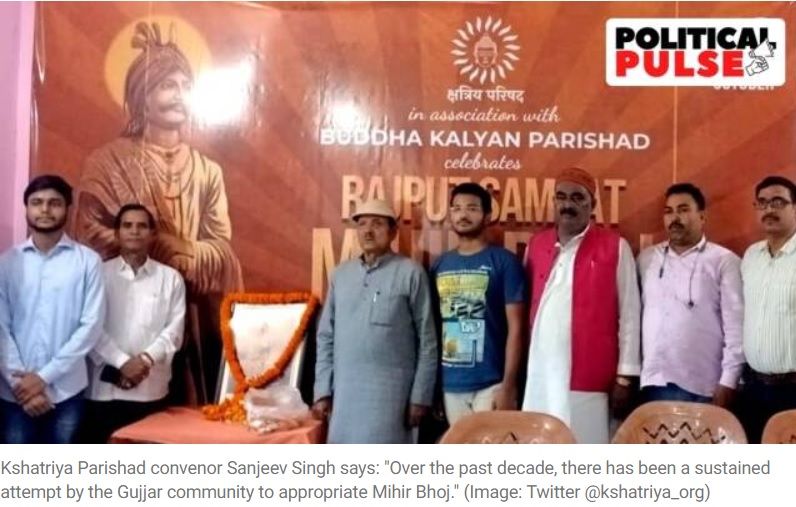King Mihir Bhoj, Rajput or Gujjar: Controversy resurfaces, this time in Bihar
Published on The Indian Express.
A ‘Kshatriya Parishad’ has started a campaign in Bihar to “reclaim” the ‘Gurjara-Pratihara’ king as a Rajput; says ‘Gurjara’ reference in name to a region, wrong to call him Gujjar.
A simmering controversy that first broke out in September last year in western UP has moved further east, raising its head in Bihar and revealing in its wake ancient ties of caste and kinship — both real and imagined — that extend across modern political divisions.
With Gujjars taking offence at this — in an area where they are in a majority — Mayawati’s BSP jumped in. On the last day of campaigning for the 2022 UP Assembly polls in February this year, BSP candidate Manbir Singh was hoisted onto the pedestal of the same statue in Dadri, to sloganeering of “Gurjar Samrat Mihir Bhoj amar rahein”.
Soon afterwards, RJD MLA Sudhakar Singh, who recently resigned as Bihar’s agriculture minister, launched a website on the king. A prime mover behind the Kshatriya Parishad, he claims his project is based on historical references. Joining them in their efforts is Arunoday Singh Parihar of the erstwhile Nagod princely state in Madhya Pradesh, who claims to be a descendant of Mihir Bhoj.
“I’m the 44th generation descendant of Mihir Bhoj. Initially, we had ignored the news of his statues being installed in Dadri and elsewhere. Our family argued that with reams of recorded history in our favour, we had no reason to prove our antecedents. But after the September 2021 episode, in which there was an attempt to declare Mihir Bhoj as a Gujjar king, we decided to raise awareness,” says Arunoday, 27.
Kshatriya Parishad convenor Sanjeev Singh says: “Over the past decade, there has been a sustained attempt by the Gujjar community to appropriate Mihir Bhoj. We found no reason to oppose them when they were installing the king’s statues across villages of Haryana and UP, all the way to Gwalior. But when they tried to change history by calling him a Gujjar, we had to object. They are in fact getting new literature published to appropriate the legacy.”
Pictures of #RajputSamratMihirbhojPratiharJyanti celebrations in Kanpur organised by Kanpur-Bundelkhand Chapter of Kshatriya Parishad.
— Kshatriya Parishad (@kshatriya_org) October 18, 2022
Event was coupled with launching of https://t.co/KTXKggrAnQ in Bundelkhand div. by chapter incharge @HarshitVais & co-incharge @kunalsinghvais. pic.twitter.com/wImzXPXRM2
Sanjeev Singh says the Kshatriya Parishad has many historians as members, and it is retelling Mihir Bhoj’s story with primary references, without running down any individual. Trying to disprove the Gujjar claim, a historian associated with the Parishad, Virendra Singh Rathod, quotes the Journal of the Royal Asiatic Society, 1894, and says the Jodhpur inscriptions of the Bauka Pratiharas from 836 CE say king Harishchandra Pratihara, the earliest recorded Pratihara king, had two wives. The progeny of the Brahmin queen were identified as Brahmins, while those born of the Kshatriya queen were identified as Kshatriya Pratiharas, and went on to become rulers. He also brings up other historical artifacts to bolster the claim.
Pratipal Bhatia, the head of the History Department at University of Delhi, also argues that what matters is the meaning of Gurjara in a particular context. “Gurjara is not only the name of a people, but also of a country and of all the people who inhabited it, irrespective of their caste or clan.” He adds that the word Gurjara (as opposed to the modern caste name Gujjar) was applied to the Pratiharas when they became rulers of Gurjaratra, the modern day Gujarat.

